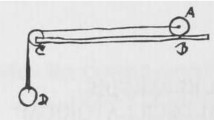Summary
The relativistic statics of threads, also leaning on smooth surfaces, is treated by making reference to the following picturesque, apparent paradox. A rope is partially leaned on a 90° arc of a sheave without friction and is subject to terminal forcesF 1 andF 2 equal toF 0 for the rest observerS. For a second observerS′ having a velocity—v with respect toS and directed asF 2, the latter forceF′2 appears equal to the rest valueF 0 whilstF′1=F 0(1−v 2/c 2)1/2. The apparent paradox is solved both in the synchronous and in the asynchronous formulation. In the former the key to the solution lies in the fact that the tensionT is not tangent to the rope. In the asynchronous formulationT is tangent to the rope but the reaction of the sheave is no longer perpendicular to the rope, thus creating a progressive variation of |T| along the rope.
Riassunto
La statica relativistica dei fili, anche appoggiati su superfici lisce, è trattata facendo riferimento al seguente apparente, e pittoresco, paradosso. Una fune è parzialmente appoggiata su 90 gradi di arco di una puleggia senza attrito ed è soggetta a forze terminaliF 1 edF 2, uguali adF 0 per l’osservatore in riposoS. Per un secondo osservatoreS′ avente una velocità—v rispetto adS e diretta comeF 2, quest'ultima si trasforma inF′2 ancora uguale al valore di riposoF 0 mentreF′1=F 0(1−v 2/c 2)1/2. L’apparente paradosso è risolto sia nella formulazione sincrona che in quella asincrona. Nella prima la chiave della soluzione sta nel fatto che la tensioneT non è tangente alla fune. Nella formulazione asincronaT è tangente alla fune, ma la reazione della puleggia non è più perpendicolare alla fune, originando in tal modo una progressiva variazione di |T| lungo la fune.
Резюме
Рассматривается релятивистская статика нитей, опирающихся на гладкие поверхности, обращая внимание на следующий кажущийся парадокс. Трос опирается на дугу 90° блока без трения и подвергается действию силF 1 иF 2, равныхF 0 для покоящегося наблюдателяS. Для второго наблюдателяS′, имеющего скорость—v относительно наблюдателяS и направленной поF 2, последняя силаF′2 оказывается равной покоящейся величинеF 0, в то время какF′1=F 0(1−v 2/c 2)1/2. Кажущийся парадокс разрешается и в синхронной и в асинхронной формулировках. В первой формулировке идея решения основана на том факте, что натяжениеT не является касательным к тросу. В асинхронной формулировкеT является касательным к тросу, но реакция блока уже не перпендикулярна к тросу, так что образуется прогрессирующая вариацияT вдоль троса.
Similar content being viewed by others
References
M. von Laue:Verhandl. Deutsch. Phys. Ges., 513 (1911);P. S. Epstein:Ann. der Phys.,36, 779 (1911).R. C. Tolman:Relativity, Thermodynamics, Cosmology (Oxford, 1950), p. 79;H. Arzeliès:Dynamique relativiste, Fasc. I (Paris, 1957), p. 29;R. Becker:Teoria dell'elettricità, Vol.2, Sect. 99b) (Firenze, 1950), p. 434;W. K. H. Panofsky andM. Phillips:Classical Electricity and Magnetism, II Ed., Sect. 17-5 (Reading, Mass., and London, 1962), p. 317. See alsoC. Møller:Kong. Danske Vid. Medd.,36, 1 (1967).
H. Arzeliès:Nuovo Cimento,35, 783 (1965).
G. Cavalleri andG. Salgarelli:Nuovo Cimento,62 A, 722 (1969).
S. Aranoff:Nuovo Cimento,10 B, 155 (1972).
Ø. Grøn:Nuovo Cimento,17 B, 141 (1973).
S. Pahor andJ. Strnad:Nuovo Cimento,20 B, 105 (1974).
F. Rohrlich:Nuovo Cimento,45 B, 76 (1966);H. Arzeliès:Nuovo Cimento,35, 783 (1965) andA. Gamba:Amer. Journ. Phys.,35, 83 (1967(see, for example,T. W. B. Kibble:Nuovo Cimento,41 B, 72, 84 (1966);R. Penney:Nuovo Cimento,43 A, 911 (1966);A. Staruszkievicz:Nuovo Cimento,45 A, 684 (1966);L. de Broglie:Compt. Rend.,264 B, 1173 (1967);265 B, 589 (1967)).2 .2 of ref.(3)G. Cavalleri andG. Salgarelli:Nuovo Cimento,62 A, 722 (1969),S. Aranoff:Nuovo Cimento,10 B, 155 (1972).S. Pahor andJ. Strnad:Nuovo Cimento,20 B, 105 (1974).G. Cavalleri andG. Spinelli:Nuovo Cimento,66 B, 11 (1970).
K. A. Johns:Lett. Nuovo Cimento,4, 351 (1970).
Author information
Authors and Affiliations
Additional information
Переведено редакцией.
Rights and permissions
About this article
Cite this article
Cavalleri, G., Spavieri, G. & Spinelli, G. Ropes and pulleys in special relativity (relativistic statics of threads). Nuov Cim B 25, 348–356 (1975). https://doi.org/10.1007/BF02737685
Received:
Published:
Issue Date:
DOI: https://doi.org/10.1007/BF02737685



